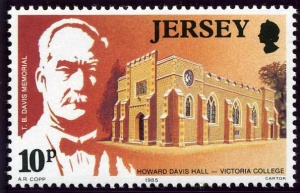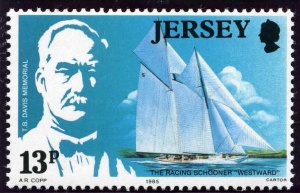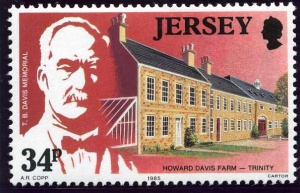T B Davis - benefactor
Davis at the helm of Westward
|
Morning service
One Sunday morning in the early 1880'S a young boy walked into St Luke's Church during morning service. There would have been nothing remarkable in this, but for the fact that the boy was thought to have been drowned at sea and mention was to have been made of this during the service. That boy was Tom Davis.
Thomas Benjamin Frederick Davis was born on 21 April 1867. He was the son of Thomas Leopold Davis, a ship's carpenter, and Jemima Davis (née Vickers). The family lived at Havre-des-Pas and as a boy Davis was in the choir of St Luke's Church, where one of his fellow choristers was Reginald Wingate, who was later to become Sirdar of the Sudan for nineteen years, a general and a Knight. The incumbent at the time of the 'Memorial Service' was Canon Philip R P Braithwaite, who was startled to see Davis in the congregation that Sunday morning. After the service he said to him "Tom, you did give me a surprise", which must have been a masterpiece of understatement.
Aground in the North Sea
After a modest education at St Luke's School at 2d a week, Davis went to sea at the age of fourteen years. It was in the month of November that his first ship, the Satellite, a three-masted brigantine of 245 tons, owned by R Allix and registered at Guernsey, encountered rough weather and ran aground in the North Sea on the Haisborough Sands off the coast of Norfolk. Davis answered the Captain's appeal for a volunteer to man the punt in an endeavour to save the ship's papers and the Captain's valuables, including his top hat.
The painter broke and Davis was cast adrift. He sculled out to sea and managed to keep his small craft from being swamped by bailing it out with the hat. Thirty-six hours later he was picked up half frozen by the Norwegian vessel Urda, whose crew of five knew no English, but kept on repeating the name 'Southampton'. It was, however, at Cowes that Davis eventually landed. As one writer observes, the next time Davis was to visit that mecca of yachtsmen was in 1923, when he went to race in Britannia as the guest of King George V. In passing, it is worth noting that the Satellite was refloated and made her way to Southampton, and it was from this source that the news came that Davis was believed to have been drowned.
Return home
Young Davis made his way to Southampton and presented himself to the Captain of the Channel Islands mailboat, who took him back to Jersey, where his return caused a sensation, for he was thought to have been lost at sea. He landed on a Sunday morning and made his way home, whence his joyful parents packed him off to church, as has already been recalled.
It was then back to sea for Davis. He served in sailing ships and three times went round the Horn. He sailed before the mast and rose to be a Captain. For a time he was in the RNVR and taught gunnery on The President. He then settled in South Africa, where he purchased a wharfinger business. He was a man of great ability, especially with regard to the handling of men, and the business prospered. Eventually he controlled most of the stevedoring services from Durban to Mombasa. Davis had now become a very rich man.
Davis married Minnie Bagge and had seven children, three of whom died in infancy. The second son, Howard Leopold, died as the result of severe wounds received in the Battle of the Somme during World War 1.
King's friend
He had a great love of sailing and through this interest became a friend of King George V. He owned the magnificent J Class schooner-yacht Westward, in which he first raced in 1925, and on occasion beat the King sailing Britannia. With this fine vessel, which was to be seen at Rats Corner in St Helier's Harbour before World War II, he won a number of handsome trophies. On it was preserved the skiff from which he was rescued.
From 1937-1939 Davis was the Commodore of the Royal Channel Islands Yacht Club, to which he presented the Glenham Cup, which was named after his son, who now lives in South Africa. He also presented a trophy, the Howard Cup, to the St Helier Yacht Club.
Benefactor
Two facts of Davis's life have now been mentioned, his business acumen and the wealth which flowed from it and his interest in sailing. It is now time to turn to a third facet and the one for which he will be long remembered, both in the Republic of South Africa and the Island of Jersey, his many munificent benefactions.
In 1920 he presented to what was then the Union of South Africa the TS General Botha, a cruiser which had been formerly HMS Thames, which he laid down was to be used as a training ship for 200 cadets, half of whom were to be of English descent and half of Boer descent. The ship no longer exists, but the institution which Davis founded still continues as a shore establishment. Captain F B Renouf has written an interesting account of how he sailed the General Botha from England to South Africa.
To Durban he presented the Howard College, which was set up on 50 acres of land presented by the Corporation. The college, which was for the teaching of engineering in all its branches, was in 1931 to become part of the University of Natal. He gave to the college a portrait and statue of King George V. The latter was unveiled by Gen Jan Christiaan Smuts.
During World War II Davis gave £100,000 to establish a fund to promote recruiting in the Union by making provision for the dependants of servicemen killed in the War. In spite of having left Jersey for so many years, Davis never forgot his birthplace and many were the benefactions which he made to the Island. In 1928 he gave Parkfield, Trinity, with its 40 vergees of land, to the States for an experimental farm. The following year he obtained with the aid of E B Renouf, the well known solicitor, a Royal Charter for the establishment of the Howard Leopold Davis Scholarship Trust with a capital of £50,000 to assist local boys to enter some form of imperial service. The terms of the Charter have since been varied.
In 1935 Davis presented the Howard Davis Hall to Victoria College, in which to house the magnificent full-length portrait of the King which he also gave to the College. The portrait is by John St Helier Lander (1868-1944), a Jerseyman, and was exhibited in the Paris Salon in 1934. The artist painted identical pictures for Guernsey and Australia House, Canada House and New Zealand House, London, which were endowed by Davis. The foundation stone of the Hall was laid by Mrs Davis in 1934, and the Prince of Wales opened the building and unveiled the Portrait on 23 July 1935. On the same day Davis gave the Prince £50,000 for the Widows and Orphans Fund of the Company of Master Mariners. Two years later he gave the Howard D to be Jersey's lifeboat.
Howard Davis Park
Plaisance, the property of the Falle family, was for sale and Davis gave £25,000 to purchase it for the Island with a view to converting it into a park. The residence was demolished and the grounds landscaped by J A Colledge. The park was opened on 30 September 1939. Just within the main entrance stands the statue of King George V by Sir William Reid Dick, which was also commissioned by Davis. In the Memorial Hall close to the main entrance is a full-length painting of Howard Leopold Davis by Jessie Hilson.
So the story of Davis's benefactions continued £25,000 for the assistance of the families of Jersey's servicemen; Glenham Hall, which is situated at New St James's Place, and substantial donations to the Channel Islands Refugee Fund in the United Kingdom.
The benefaction, if one may so describe it, which was most characteristic of this generous man, was that which took the form of substantial cheques for the survivors of the Urda, the vessel which picked him up in the North Sea all those years ago. In 1936 he visited Oslo and other Norwegian ports in the Westward and did not leave Norway until he had traced, with the help of Prince Olaf, the two surviving members of Urda's crew and the dependants of the other three. The ship's carpenter who had actually lifted Davis aboard the Urda all those years before was one of the two still living.
The last benefaction was St. Luke's Hall, which Davis never saw completed. As he had remembered the men of the Urda, so he remembered one of the scenes of his youth, St Luke's Church.
T B Davis died at Durban on 27 September 1942. In accordance with his wishes the Westward, which had given him so much pleasure during life, was sunk in Hurd Deep after his death.
Davis was a man of strong personality who did not suffer fools gladly and always called a spade a spade. He was a man's man. But behind this somewhat sturdy exterior, there was concealed a great and generous heart. His benefactions speak for themselves and were dictated by his belief in King, Country and Empire, and, of course, his native Island of Jersey.








